Ryzen 4000 performance benchmarks: Ryzen 7 4700U beats Intel H-class mobile chips - morrisfromeannown
Our initiative sample of the AMD Ryzen 7 4700U came in the form of the affordable Acer Dean Swift 3 laptop computer. After AMD launched its 7nm Ryzen 4000 Central processor family at CES and dealt a first, crushing blow with the Ryzen 9 4900HS chip in high-end notebook PCs, the Ryzen 7 4700U tackles the next take exception: U-sort out, gauze-like-and-light laptops. The company's offerings in this area have been weak in the past, so AMD concentrated on optimizing Ryzen 4000 for thinner notebook computer PCs. Everyone wants to know if AMD's Ryzen "U" chips finally have what information technology takes.
Check out our air-filled Ryzen 7 4700U revue for the highlights, and if you want to dive deeper, present are complete the additional benchmarks we ran on the CPU.
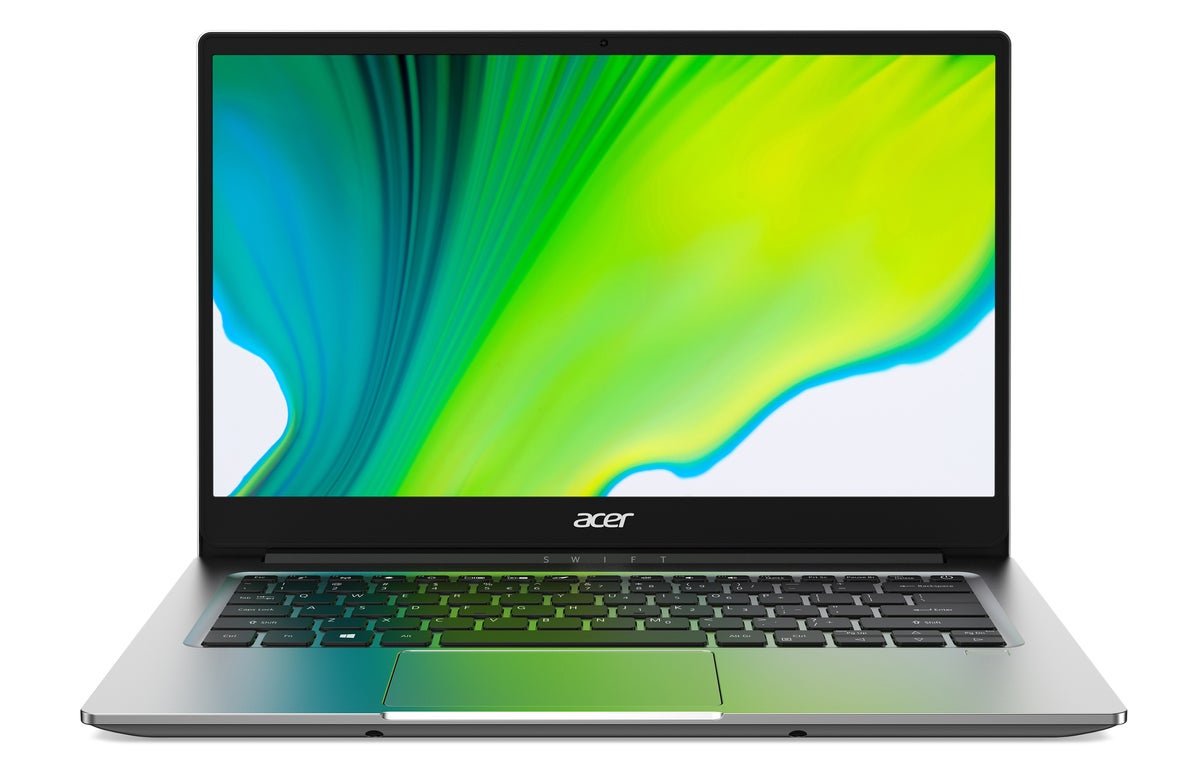 Acer
Acer The bulk of our examination was done on a "budget" Acer Blue-belly 3 with a 14-edge in screen door, 512GB SSD, 4GB of LPDDR4X/3733 and Ryzen 7 4700U.
How we tested
As you can't test a laptop computer CPU by itself, we selected three models to represent their several CPUs. Acer's Swift 3 SF314-42 debuts with AMD's Ryzen 7 4700U, code-named "Renoir." This budget CPU features 8 cores, but without Symmetrical Multi-Threading (that's reserved for the Ryzen 7 4800U), so it's limited to 8 total threads. The Swift 3 comes with 8GB of LPDDR4X/3733 RAM and a 14-inch display.
Representing Intel are Dell's XPS 13 7390 with Intel's Comet Lake U 10th-gen Core i7 10710U, and Dell's XPS 13 2-in-1 7390 with Intel's Frost Lake 10th-gen Core i7-1065G7. The top-finish Comet Lake U features 6 cores and 12 threads, while the Ice Lake fleck features 4 cores with 8 threads. We consider some XPS laptops to be white comparisons, as they usually high the charts in execution ended most of the laptops we see. They some have 16GB of Drive in compared to the Acer's 8GB, but the Dingle XPS 13 7390 uses slower LPDDR3, while the XPS 13 2-in-1 uses LPDDR4X/3733. The XPS 13's exhibit is 13.3 inches, and the XPS 13 2-in-1's screen is 13.4 inches.
All three laptops were running the in vogue public build of Windows 10 (1909 18363.815) and the in style drivers and UEFI, to bring them in line with whol of the security mitigations. Piece the Acer didn't appear to have any performance settings other than Windowpane 10's slipper (remember, IT's a $650 budget laptop), some Dell XPS laptops were run using their Ultra Performance settings.
We likewise want to mention that examination three laptops at home during shelter-in-place required some accommodation. With close temperatures always shifty in our tryout research laboratory-slash-dining room, we stopped testing when the temps got likewise high. For consistency, all of the results we show are from the laptops running the same tests at the same fourth dimension.
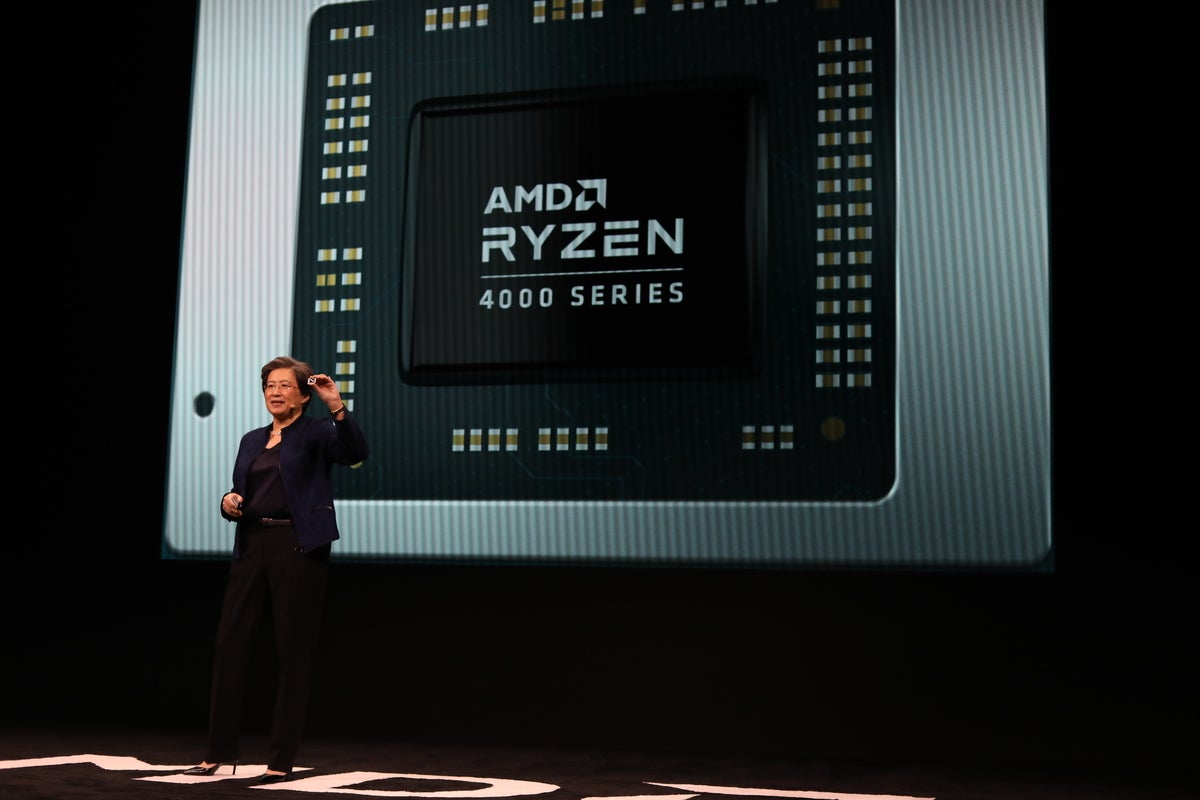 Gordon Mah Ung
Gordon Mah Ung You get a Ryzen 7 4700U! And you get a Ryzen 7 4700U! OK, non rattling, but wouldn't it be nerveless if AMD had an Oprah import?
Ryzen 7 4700U Central processing unit Performance
We'll kick this off with Maxon's Cinebench R20. IT's a recently updated mental testing made to measure how fast a CPU renders a 3D model. IT uses the company's Cinema4D railway locomotive, which is introjected into John R. Major products including Adobe Premier Professional CC.
Intel has argued that exploitation 3D modelling benchmarks isn't useful in thin-and-light laptops, because very hardly a people buy them for that rather work. While we fairly agree, we also see there's enough performance potential straight off in thin-and-lights that you could shed a few pounds (in power brick, too), hitherto still relish multi-core execution.
Cinebench R20 Performance
As the chart at a lower place shows, you could enjoy plenty from Ryzen 7 4700U, which was 23 pct faster than Intel's most advanced 10th-gen Core i7-1065G7 chip. It's also about 14 percent quicker than Intel's top-end 6-heart, 12-thread Core i7-10710U. Remember: This Ryzen 7 4700U doesn't even have SMT steamy.
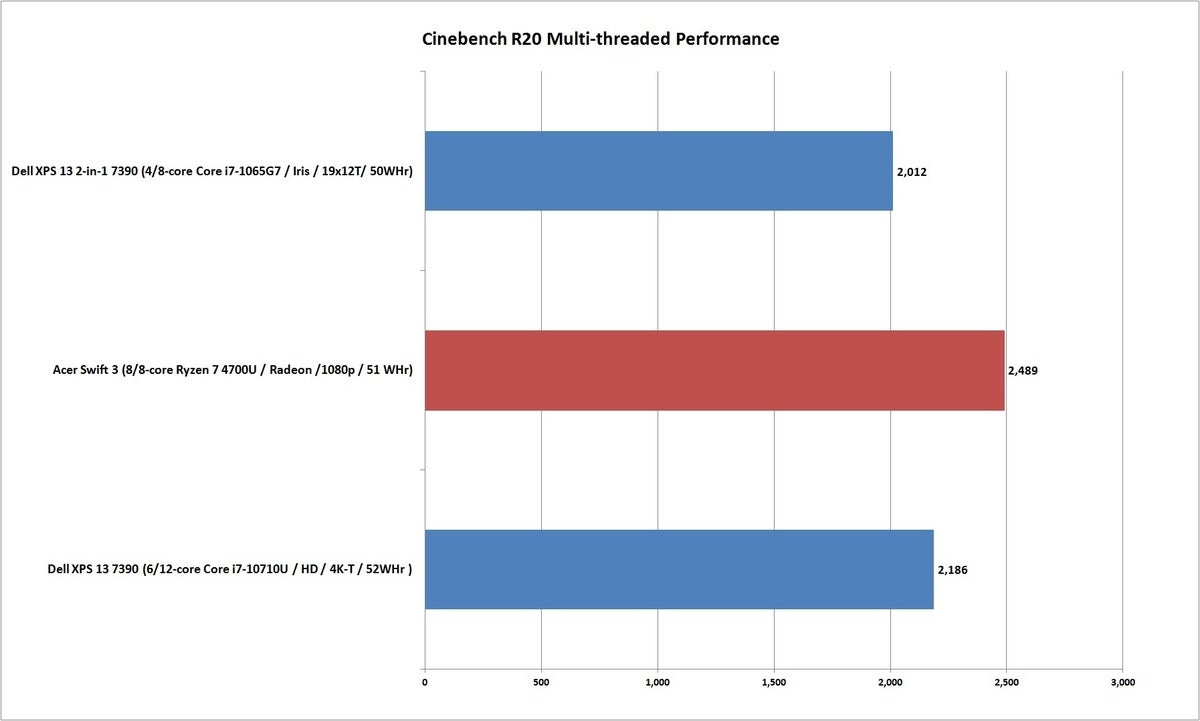 IDG
IDG AMD's budget Ryzen 7 4700U in the Acer Swift 3 easily puts both premium Intel 10th-gen U-chips to log Z's.
To revolve around Intel's contention that single-rib performance matters virtually, we use Cinebench R20 congeal to a individualist wind. IT's not the same As running a magical spell-check in Microsoft Word, but it does make you an indication of the poker chip's performance under load.
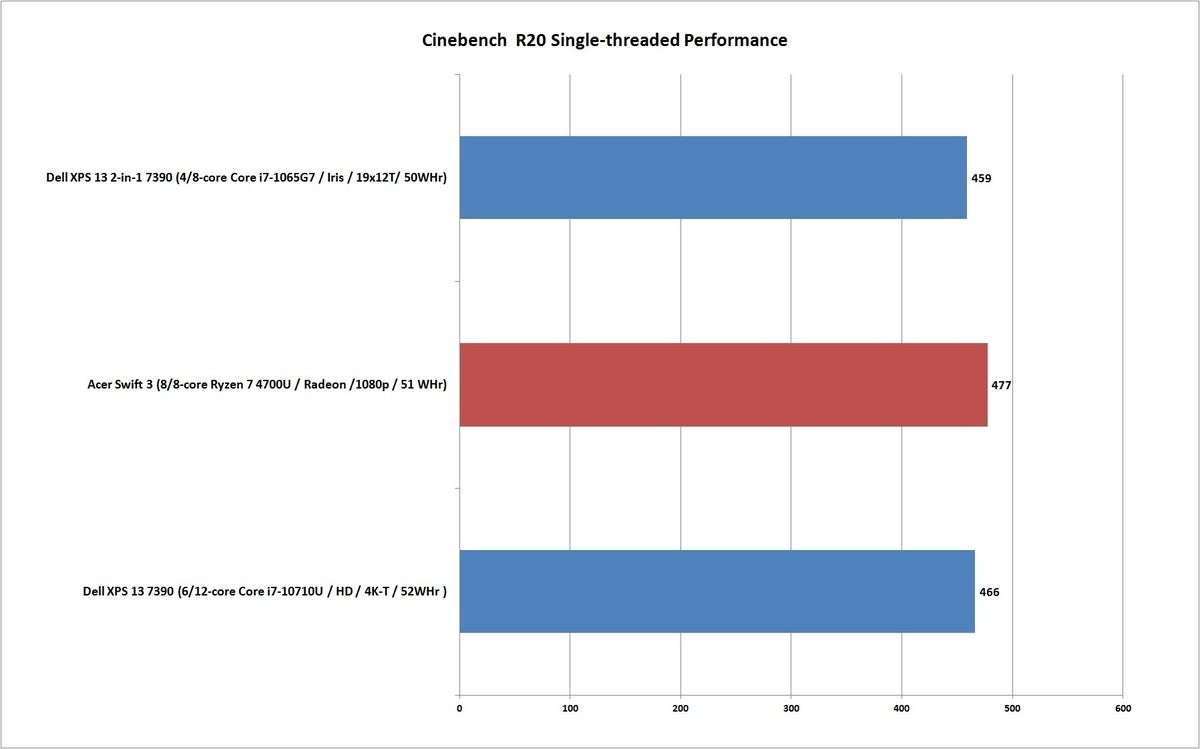 IDG
IDG Cinebench R20 puts the Ryzen 7 slightly ahead of both Intel chips, only it's essentially a tie.
The results above are basically a standoff. The "winner" here is Ryzen 7 4700U, which comes in slightly ahead of the Core i7-10710U Comet Lake U. You'd await the Comet Lake U's 4.7GHz turbo boost clock to win this over the Ryzen 7 4700U's 4GHz boost time, but Cinebench R20 takes remote longer to move than the old Cinebench R15 and uses AVX, AVX2, and AVX512, which can press down on the boost pin grass. (See our Cinebench R15 results at the end of the review.)
HandBrake 1.3.1 Performance
Our next Processor test measures performance under more stressful conditions. We normally function an older, 0.9.9 version of the free HandBrake public-service corporation to convert a 30GB, 1080p picture using the Android Tablet preset. Both 1080p and Mechanical man tablets are close to as far backside the States as 2014, though, thus we took this chance run the latest public version of HandBrake, rendering 1.3.1, and change the ASCII text file 4K telecasting, Weeping of Steel, using the H.265 Matroska 1080p/30 preset.
For this test, the encode is done strictly on the x86 cores. Manifestly, the shorter result is better, because that means less time waiting for the encode.
As you can see on a lower floor, Ryzen 7 4700U wins by a air mil, climax in all but 30 percent faster than the Core i7-10710U. Against the more advanced 10nm Substance i7-1065G7, you're looking a 36-percent difference. Remember, the Ryzen 7 3700U doesn't flatbottom have SMT.
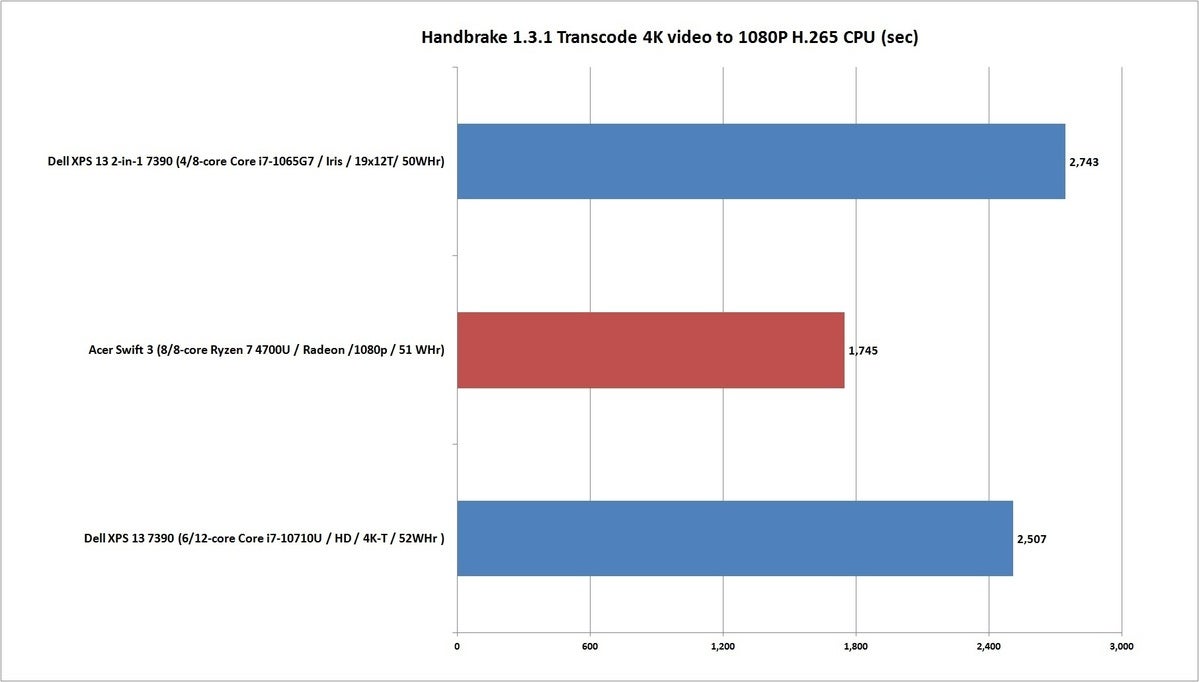 IDG
IDG The Ryzen 7 4700U crushes the Core i7-10710U and Core i7-1065G7 in an HEVC-inscribe exam.
The premature encode uses the x86 side to perform the video transcode. That's kinda old-school when you have the advanced media engines in the chips. To look at that, we utilised the duplicate 4K Crying of Steel video recording and encoded it exploitation the H.265 preset; however, we switched it to use the QuickSync encoding engine for Intel, and AMD's new VCE (Video Coding Engine). We set totally three to use the Principal Visibility setting and Peak Frame Rate at 30 Federal Protective Service (the QuickSync predetermined defaults to the older Variable Frame Rate setting, set to Same atomic number 3 Source).
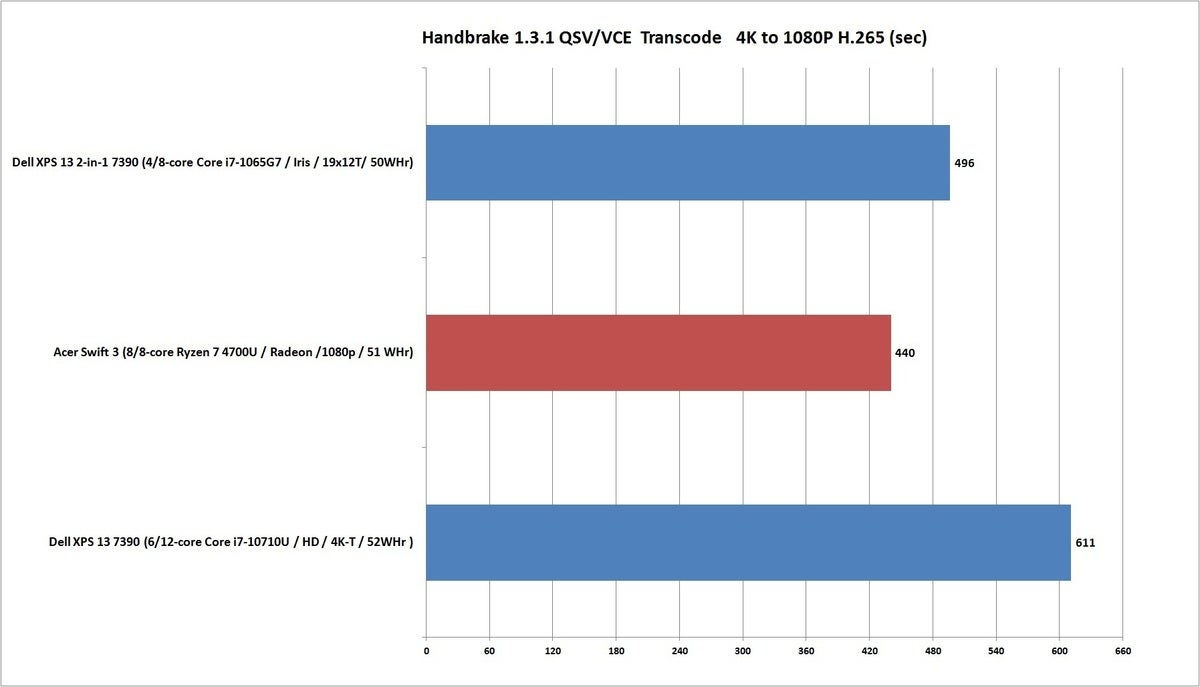 IDG
IDG VCE pulls out a decent win against QuickSync in our H.265 encode screen.
As you can examine in the graph above, AMD's VCE crosses the finish line first, about 11 pct faster than the Core i7-1065G7. The Nub i7-10710U and its older media engine are about 28 percent slower.
AMD's VCE railway locomotive wins on performance, but one variable we don't consider is the quality of the video encoded by QuickSync and VCE. Even though some are victimization the Lapp settings in HandBrake, it's not rather equal if one is producing subscript video. Perhaps we'll ask our picture nerds to check the television quality. For now, we'll noneffervescent give it to AMD's VCE.
POV-Ray Performance
In the Amiga-vintage POV-Ray ray tracing benchmark, we see the Ryzen 7 4700U undetermined upward an even larger lead. Once more, all of Intel's protests apply Hera every bit, yes, an infinitesimally small universe answer ray tracing with an app that first started with the Amiga. Nevertheless, if you do, reach for Ryzen.
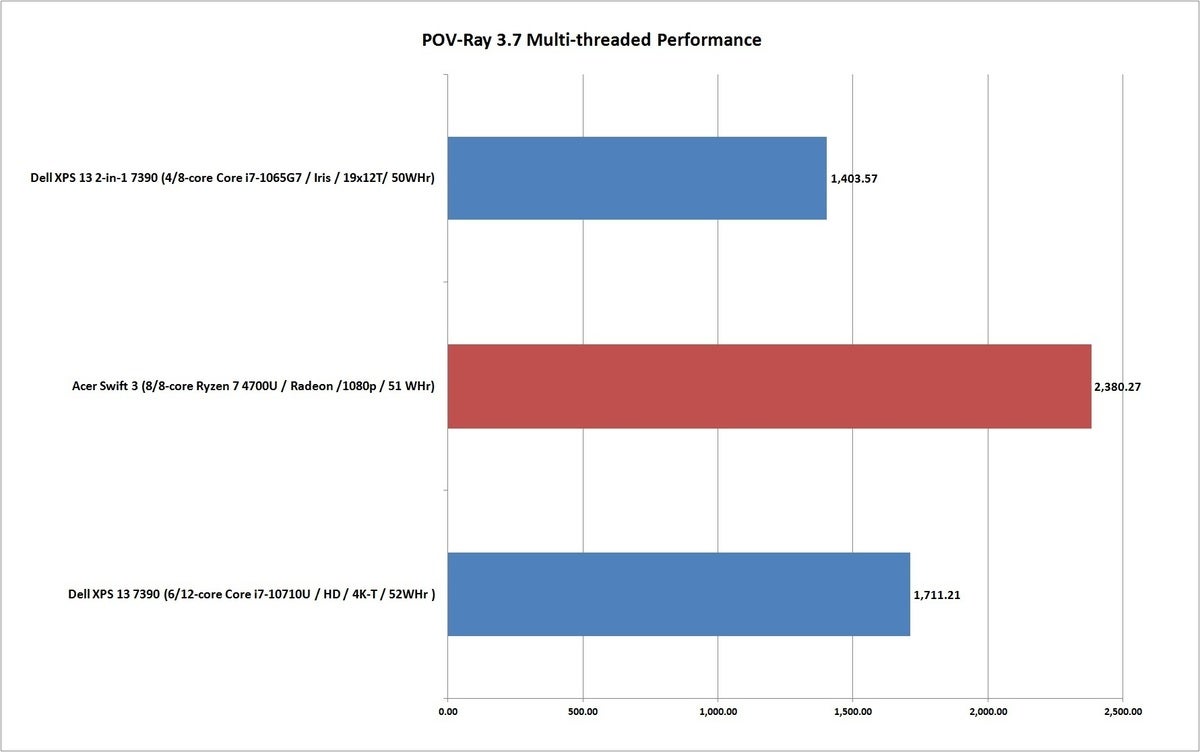 IDG
IDG POV-Ray sees the 8-heart Ryzen blow past the 4-core Ice Lake and 6-core Comet Lake U chips.
When we run POV-Ray in several-threaded way, the gaps close. All three virtually end in a tie, with the Comet Lake U slightly leading. For the well-nig part, we think that single-threaded performance between the chips is close enough that it doesn't thing most of the time.
On one hand, this is bad for Intel, because a 4.7GHz Core i7-10710U should dispatch a 4GHz Ryzen 7 chip. Then again, the 3.9GHz encourage Icing Lake chip is exact on that point too. You know what, everyone takes home a trophy today!
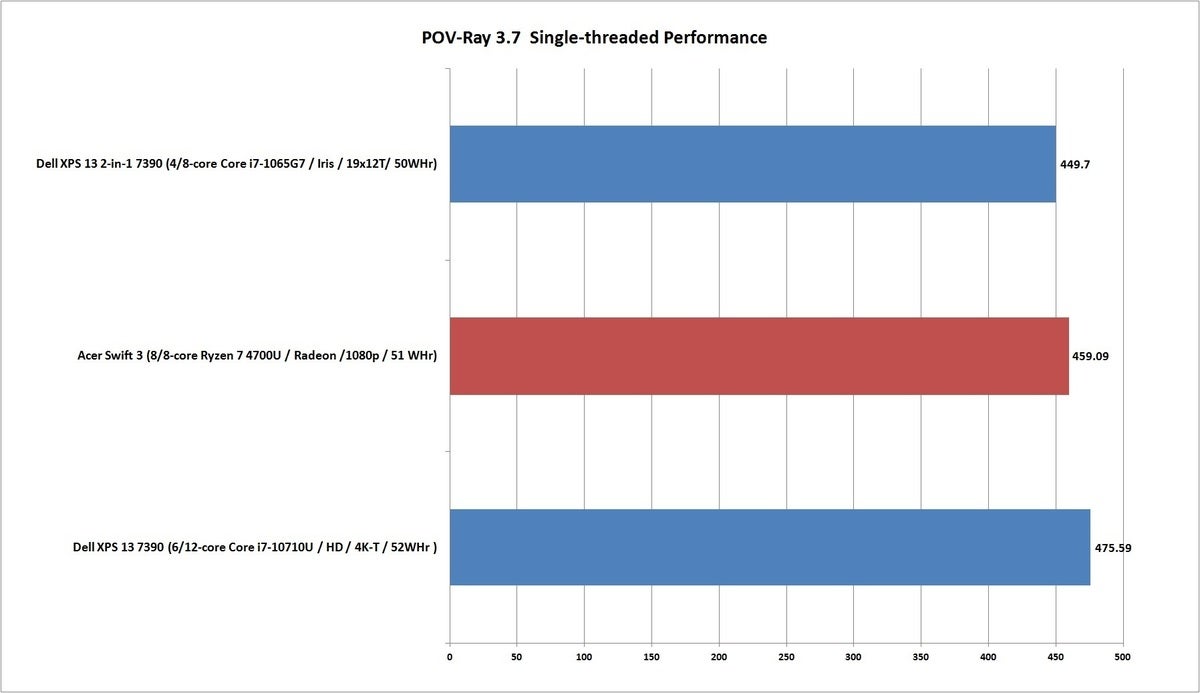 IDG
IDG IT's virtually a tie with a very flimsy edge going to the Comet Lake U chip patc the Ice Lake CPU isn't that much slower than the Ryzen 7.
V-Re Future Performance
Our last multi-core, multi-threaded 3D modelling test is Chaos Group's V-Ray Side by side. It's a physically-based render that has rough an Academy Award and has been used for the visual effects on so much minor projects American Samoa Game of Thrones. The results are a bit more interesting for the Ryzen 7, because IT loses to the 6/12 Core i7-10710U aside about 13 percent. Even the quad-core Core i7-1065G7 International Relations and Security Network't that long behind when you consider it has half the physical cores of the Ryzen 7. The Ryzen 7 4700U is presumptive hobbled by AMD's decision to partition SMT soured for only Ryzen 7 4800U customers.
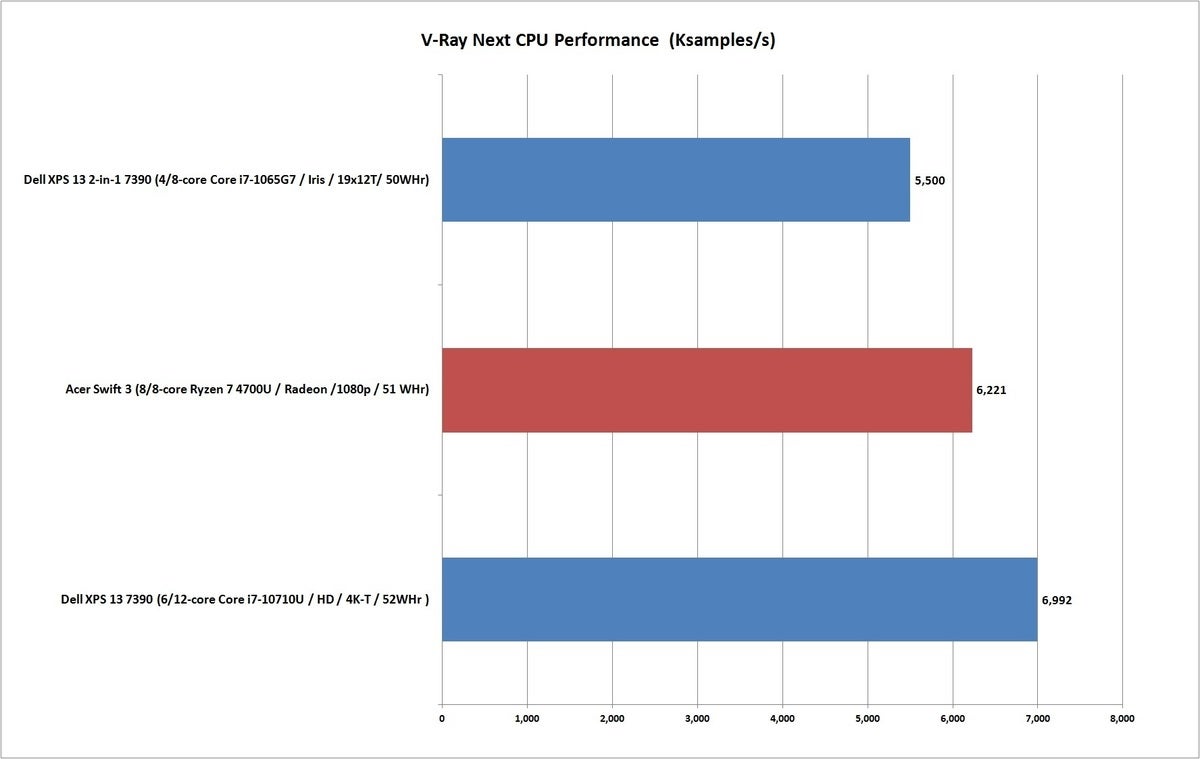 IDG
IDG The CPUs with Hyper-Threading get a nice bump in V-Ray Next over the Ryzen 7, which doesn't get SMT.
Ryzen 7 4700U GPU Performance
For the next section we'll move connected to graphics performance. The 14nm, 10th-gen Core i7-10710U offers essentially the aforesaid graphics engine we've seen for many years now, Intel UHD, with a act to denote its performance. Intel has many recently dropped the number, and we sometimes preceptor't even see the U any longer either. The 10nm, 10th-gen Core i7-1065G7 gets a much more advanced Iris Plus graphics locomotive, which was a wanted change when introduced. It's enough to bring i downhearted-king discrete Nvidia MX nontextual matter nervous.
AMD's Ryzen 7 4700U features improved Radeon Lope Felix de Vega Carpio cores, which the company said are markedly quicker and more efficient than Vega cores on older procedure generations. The Ryzen 7 4700U features 7 compute units within, which can declare oneself 1080p gaming capability. But let's be realistic: It's a incomprehensive thermal envelope with only LPDDR4X/3733 vs. a distinct GPU's GDDR6. It's only when going to take you so far. We've said the equal about Intel's much break Iris Plus graphics, too.
Still, artificial tests help illustrate the limitations. 3DMark's Flip Underwater diver (below) is well suited for basic gaming measurements. As you can see, the Ryzen 7 4700U with Radeon nontextual matter is about 12 percent faster in the graphics-only sub-test, which mostly filters out CPU performance.
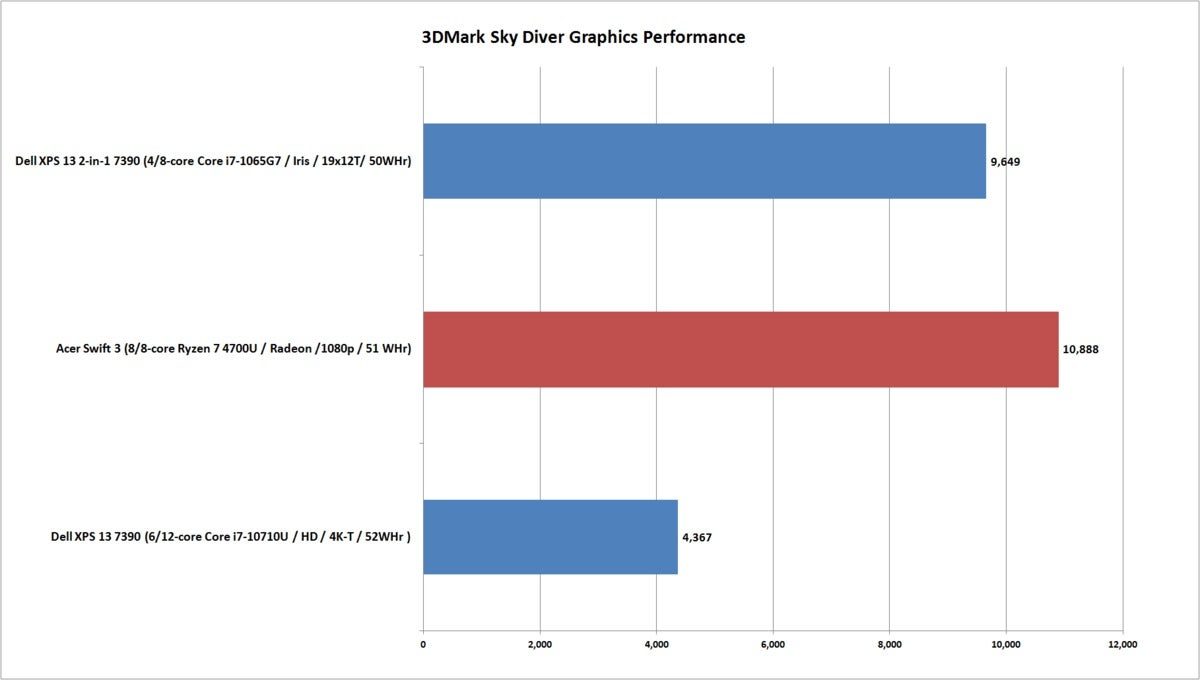 IDG
IDG We also ran 3DMark's Flak Strike essa. It's in essence a tie, with Ryzen about 3 percent faster. Yet again, both graphics cores seem closely matching.
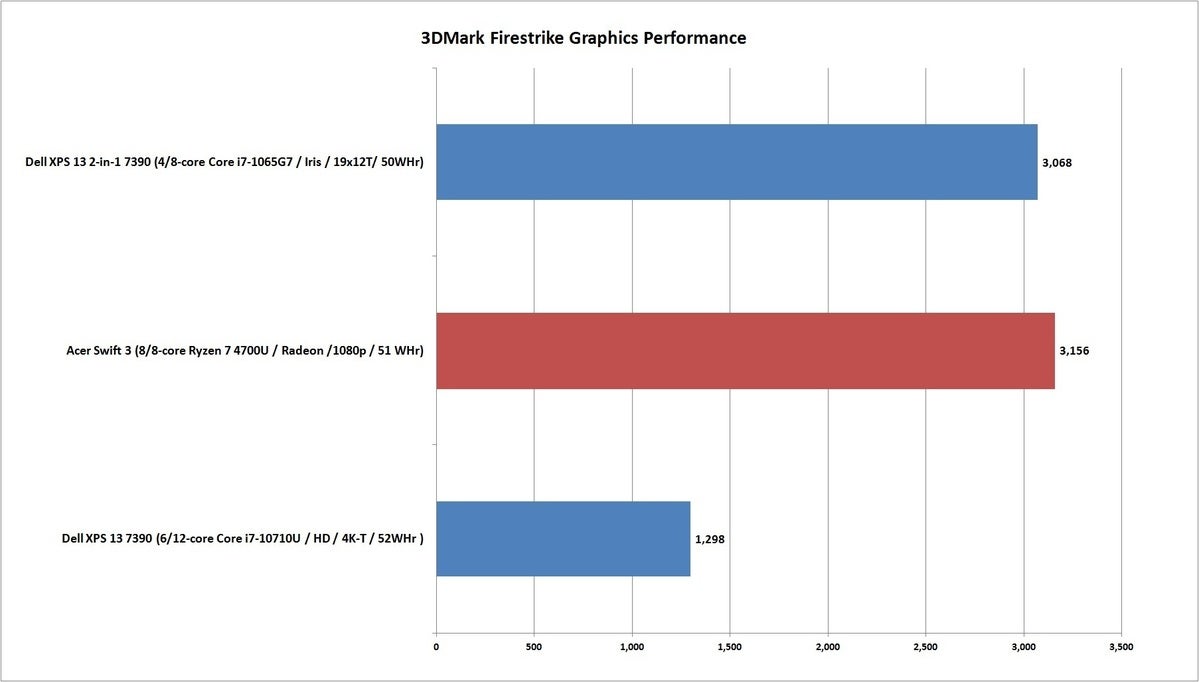 IDG
IDG Both Intel's Flag Plus and AMD's Radeon Vega cores in Ryzen 7 4700U are closely coordinated in carrying out. Intel HD, though? Yea, what are you still doing here?
In real-world gaming benchmarks, Intel's Flag Plus tranquilize has dentition. In World of Tanks at 1366×768 firmness and the benchmark set to Minimum, Iris Addition notches a pretty good deliver the goods, with a score 25 percentage higher.
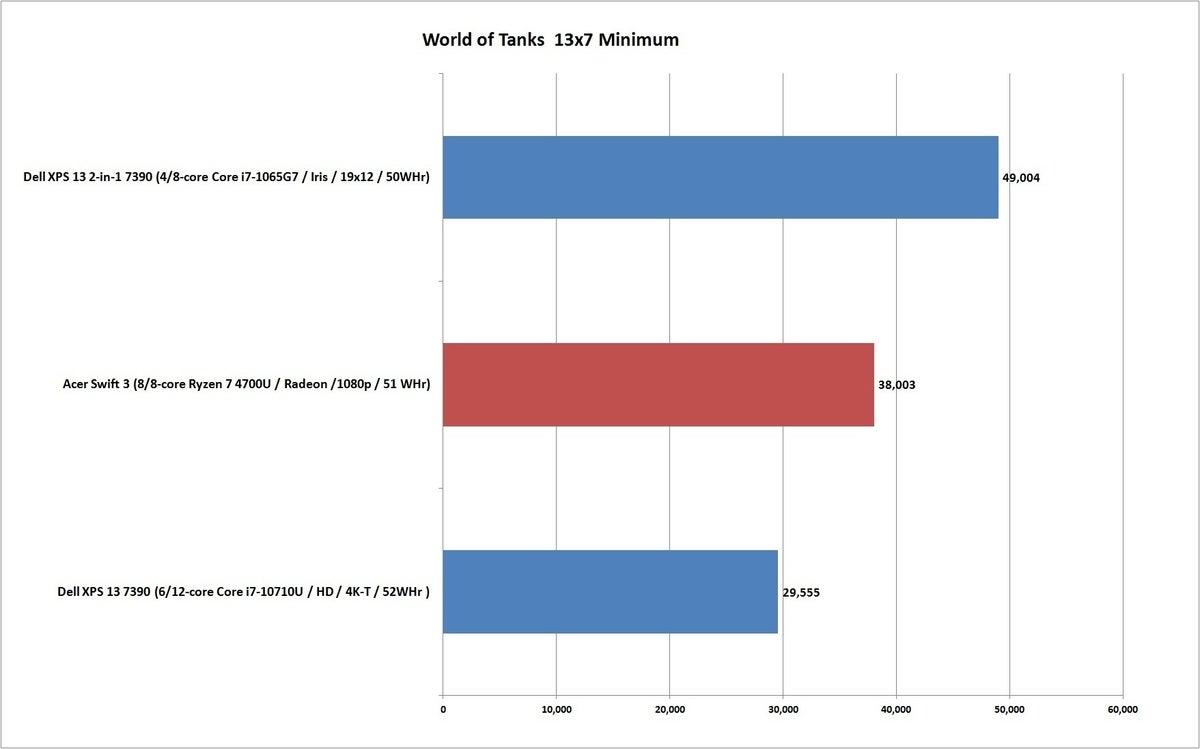 IDG
IDG At the settings you might actually play this game at, Iris Plus is a good clip faster.
Crank the World of Tanks benchmark to 1920×1080 resoluteness and "Cooked," though, and the tables are suddenly turned. We fishy you could start picking your fashio through some other six games and find the advantage for either design. For the most part, some are light years forward of previous integrated graphics implementations and would liquidate a squeeze to play at, say 720p low. Untold of that depends on your discernment in gaming and your tolerance for moving plot timbre sliders to the leftfield side instead of the right side.
Even if graphics carrying into action is fairly close, AMD's main argument persists: no compromises. With Intel's cardinal 10th-gen chips, you either choose meat count with Core i7-10710U or you chose graphics performance with Core i7-1065G7. It's clear with Ryzen 7 4700U, you can have your Twinkie and eat on it, too.
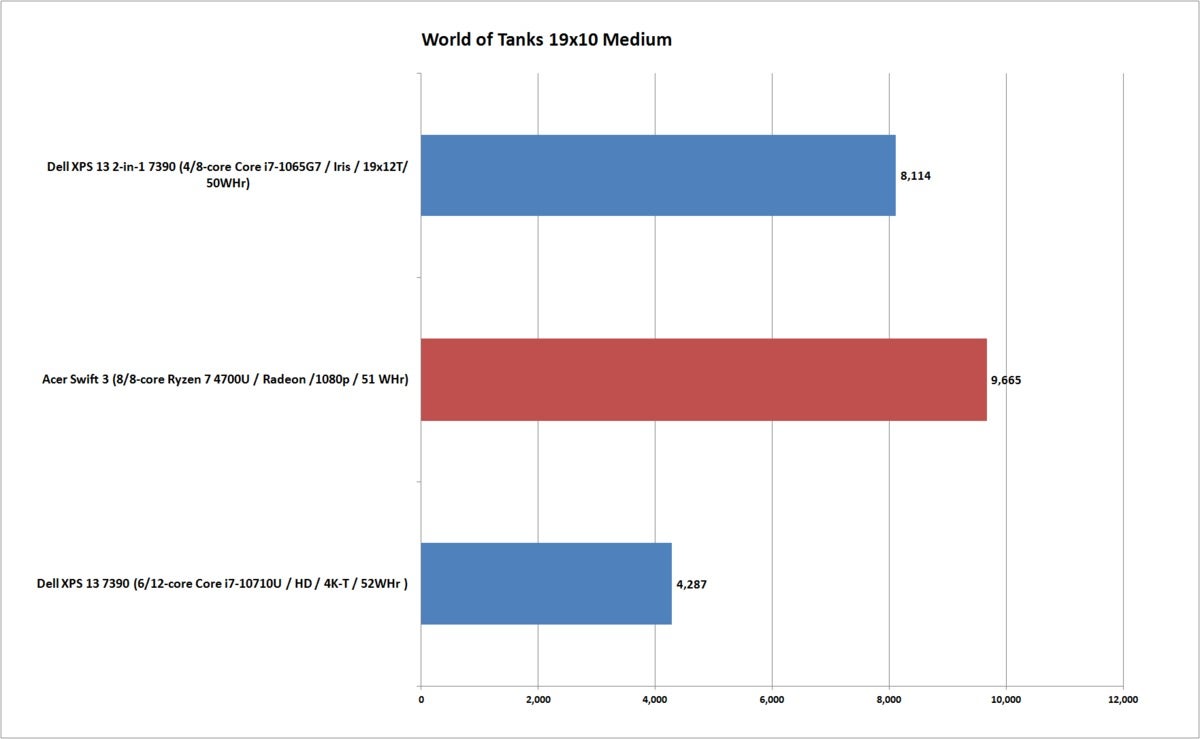 IDG
IDG Crank up the resolution and game settings and suddenly the Ryzen 7 4700U trounces the Ice Lake silicon chip by 17 percent.
Battery life matters! Keep meter reading to see how Ryzen 7 4700U fares.
Ryzen 7 4700U Battery spirit
Perhaps one metric that overshadows all is battery life. Our video rundown tryout uses the same Tears of Steel 4K telecasting and loops it victimization Windows 10's Movies & TV player (the most efficient one in town). We put off the laptop into plane mode, connect earbuds to minimize the speaker driver impact, and set test brightness to 250 to 260 nits.
Note that this chart includes some older test results. We used the official scores from the reviews of both the Dell laptops, as OS and UEFI updates should not affect this test. We also brought in the results from Recent epoch Intel-settled Swift 3 laptops we've tested, with 8th-gen Whiskey Lake and 10th-gen Ice Lake chips.
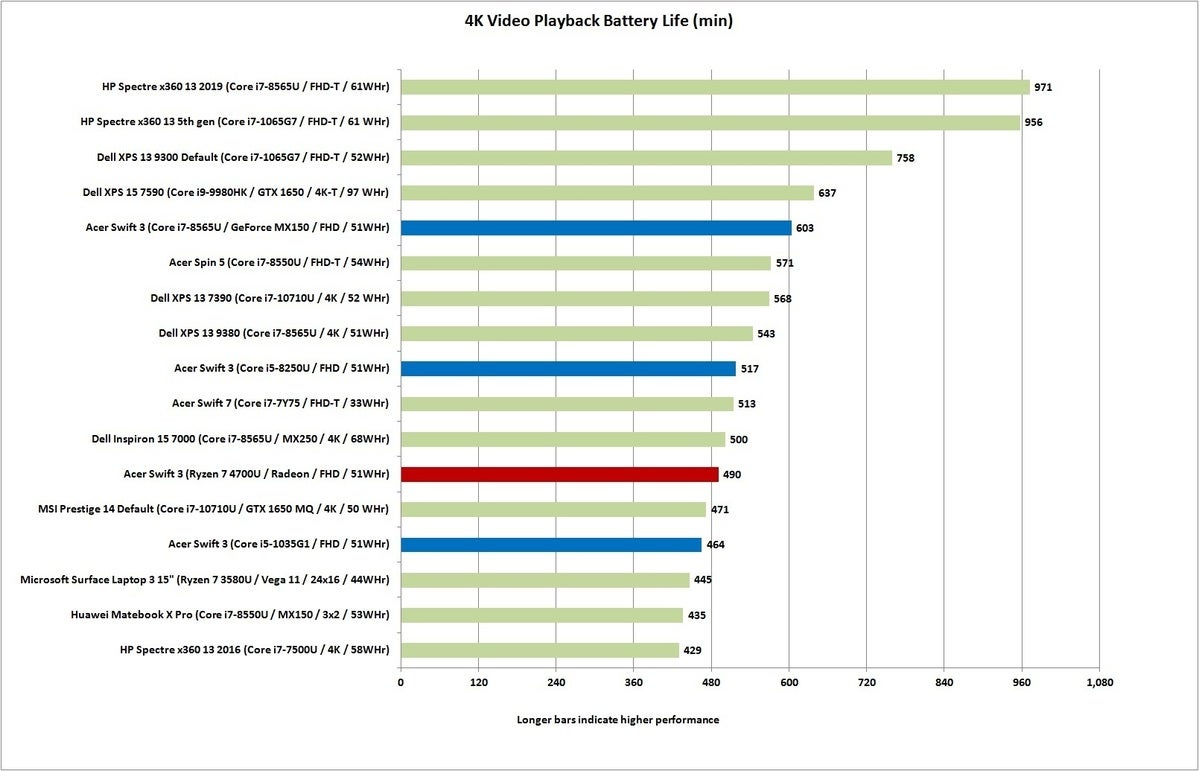 IDG
IDG Most of the Acer Swift 3 laptops we've tried, incuding this new one with Ryzen 7 4700U, let middling battery life.
Here's the cardinal place where Ryzen 7 4700U stumbles. It posts an ordinary 8 hours and 10 minutes of runtime, compared to nearly 10 hours for the XPS 13, and well-nigh 12 hours for the XPS 13 2-in-1. Also note that the XPS 13 we tested features a 4K screen door, which consumes far more power than 1080p panels such As the combined in the Acer Swift 3. The same XPS 13 with an FHD shield might have lasted an additional three to Little Jo hours.
To be fair, the Ryzen-based Swift 3 is mostly in line with two of the three other Core-based Sceloporus occidentalis 3's we've tested. At this point, we think it's unhazardous to say that battery life on the Acer Jonathan Swift 3 is within reason across the board, and it Crataegus laevigata ingest nothing to do with the Ryzen splintering. We'll wait until we've tested 7 operating theatre eight Ryzen 4000-settled laptops to establish a sheer for this CPU family. (We should note that the Ryzen 9 4900HS in the Asus ROG Zephyrus G14 gave us fantastic video rundown public presentation).
Ryzen 7 4700U: The chip that won't quit
To wrap it sprouted, we'll help you visualize the strength of the Ryzen 7 4700U: CPU performance. For that we use up the older and lighter Cinebench R15 and run it from 1 thread to the maximum amount. For the Comet Lake U Core i7-10710U, that's 12. The runs are performed sequentially, with a hardly a minutes' rest in between.
In the chart below, we see a statistical regression in carrying into action with the Core i7-10710U that is hard to understand. We think information technology might be our issues with the close room temperature. On a cooler forenoon we'll rebroadcast this, but remember: We ran the Ryzen 7 under the same conditions.
 IDG
IDG We run Cinebench R15 across every of the Central processor cores to give you an idea of how the chips perform.
We too graph out the functioning difference, under. As you can see, the Ryzen 7 4700U is aquatic along those light loads, where the higher further clocks of the Core i7-10710U possess an advantage in Cinebench R15. The Ryzen 7 4700U opens up a queen-size guide down the home debase. Even though the Core i7-10710U has 12 duds in a test that favors more threads, the 8-core-only Ryzen 7 4700U fights it to a impasse. Overall, we'd say it's a win for AMD, especially when you consider the Ryzen 7's better GPU.
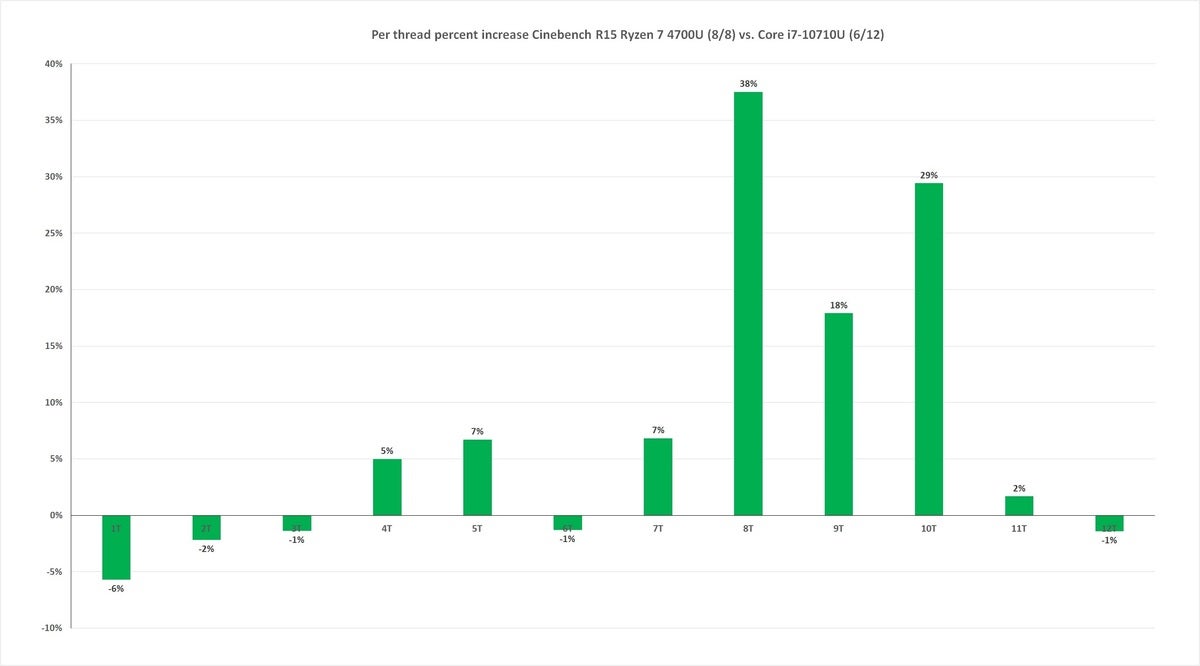 IDG
IDG Intel's most advanced 14nm U-chip, the Core i7-10710U, leads the Ryzen in single-threaded performance. It's mostly a attach on distressful loads, with the 8-kernel-only Ryzen 7 offering more interesting performance spikes.
The many interesting battle is between AMD's 7nm Ryzen 7 4700U and Intel's 10nm Core i7-1065G7. We've already seen how close the two buns be once in a while, even in graphics performance. The independent issue for the Intel chip is it doesn't go beyond 4 cores. When you compare the Ryzen 7 4700U against the Inwardness i7-1065G7, it looks like this:
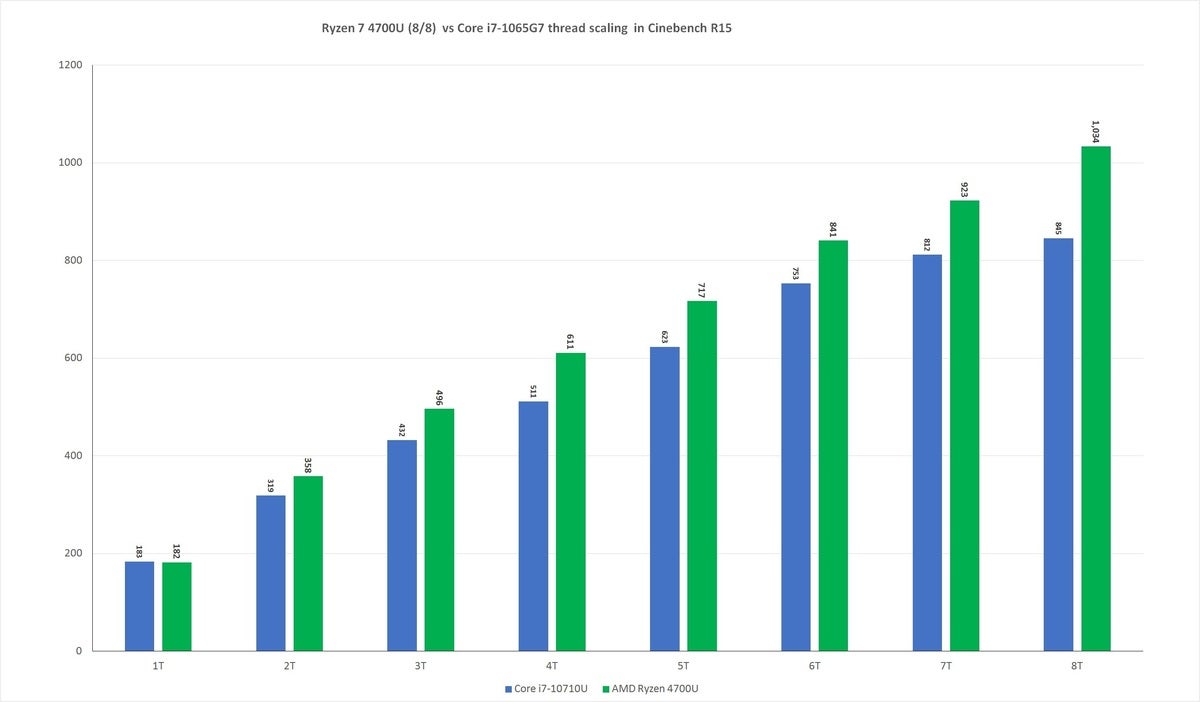 IDG
IDG Multi-core public presentation on AMD's new Ryzen 7 4700U (green) vs. Intel's most hi-tech 10th-gen Core i7-1065G7 (depressed).
That probably doesn't look like much, so here is the performance difference by pct. Both chips are actually cold even happening single-core performance, but as you ramp up, the Ryzen 7 4700U doesn't look backward. Information technology's basically double digits, with a big 22-percent difference at 8 threads. The basic example is spell Hyper-Threading helps quite an bit, it's not enough to beat 8 physical cores. This is likely to look up to justified uglier with the Ryzen 7 4800U, which has SMT (AMD's Hyper-Threading) switched happening.
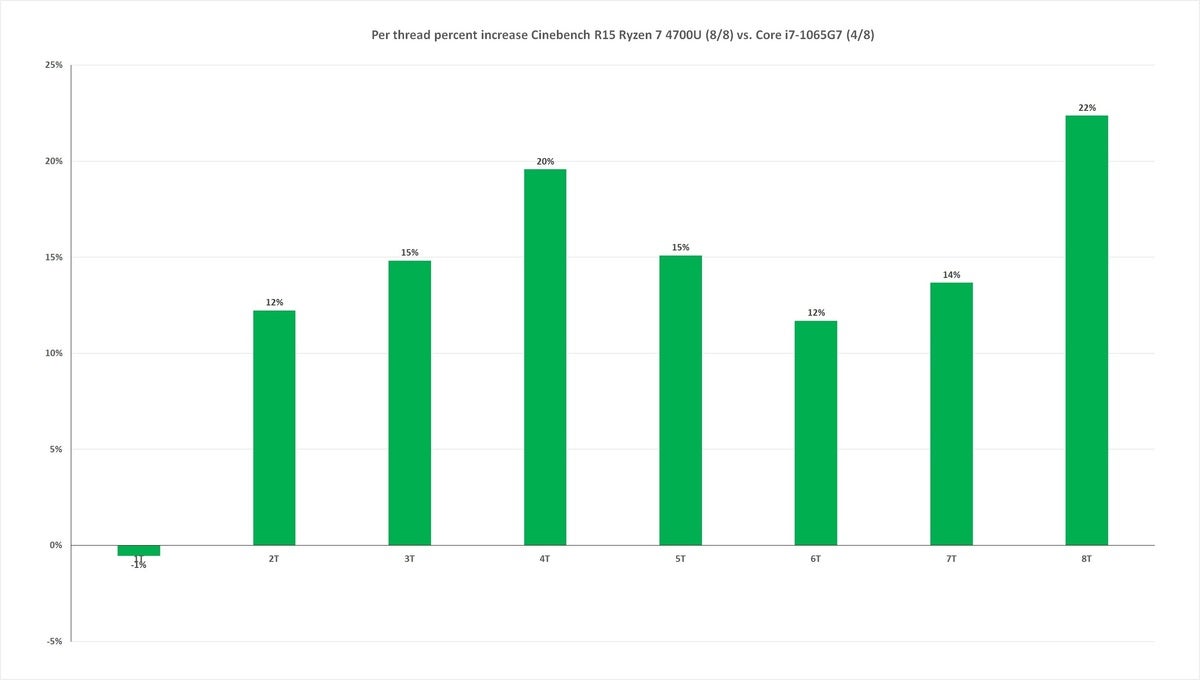 IDG
IDG The 4-CORE, 8-thread Core i7-1065G7 can't hang with the Ryzen as threads go up.
Ryzen 4000 continues to change the game
Ryzen 4000's journey is by far not perfect. During our Ryzen 7 4700U testing, we proved to create a workload exploitation Windows 10's overlooked but impressive Video Editor (yes, that's its name). We took the 4K Crying of Sword video, added ugly titles, 3D effects, and "denim" filter consequence, exporting it to 1080p.
On the Dell XPS 13 2-in-1, the externalize and export ran as smooth as butter—very impressive for an ultralight laptop. We tried the same with the Swift 3 and Ryzen 7, but the project just decorated when hardware speedup (AMD's VCE) was enabled. We're sure this takings will follow corrected once Microsoft notices, but we work this up as a reminder that AMD is moving in to a world that's been largely focused on Intel CPUs for a long, long sentence.
Before we end this, we want to assist put some perspective on AMD's Ryzen 7 4700U and Acer's Swift 3. Remember that this is a budget $650 laptop with 8GB of RAM and 512GB SSD. It's basically cooled by a various heat pipe and fan, vs. the intricate copper vapor chambers of the XPS 13 2-in-1 or double fans of the XPS 13. Even so, the Swift 3 was ever well-behaved and never the first to scandalize with devotee noise. That's intimately the same know we saw on Asus' ROG Zephyrus G14 on CPU trading operations. We can't aver the Saami for most Intel-based laptops when pushed hard.
Until no this modest Swift 3 budgetbook offers performance that actually puts it into the ballpark of Intel's 9th-gen H-class laptops. You throne see that illustrated on a lower floor, where we overleap the Acer Swift 3 into a pack of H-course of instruction gaming laptops. The yearner red line belongs to the Ryzen 9-steam-powered Asus ROG Zephyrus G14.
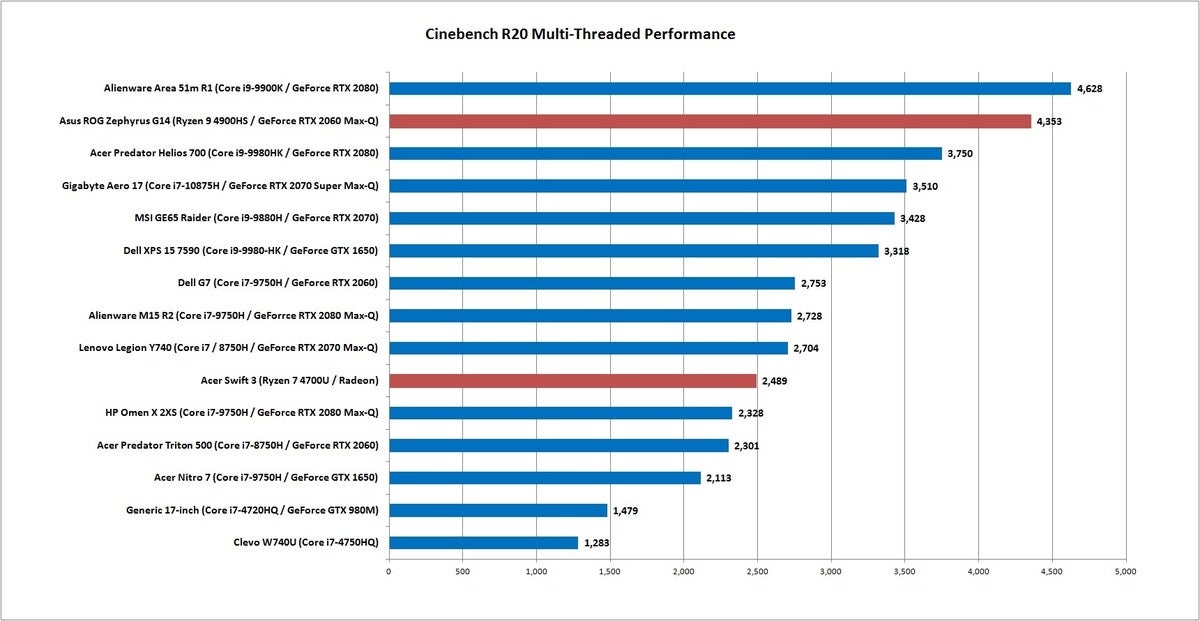 IDG
IDG The Acer Swift 3 bum actually perform as well as Intel's 9th-gen H-class CPUs in CPU operations.
We'll show it yet again in the many intensive HandBrake test, this time using the older interlingual rendition, where we transcode a 30GB 1080p MKV charge using the Android Tablet planned. The workload favors more cores and threads. The Acer Swift 3 with its Ryzen 7 4700U is succeeding with 6-core, 12-thread Core i7-8750H and Congress of Racial Equality i7-9750H chips in laptops that count quintet pounds or more, typically. Yes, those H-class gaming laptops would whup the Swift 3 silly in gambling—but in Central processing unit performance, it's way too close for comfort for Intel fans.
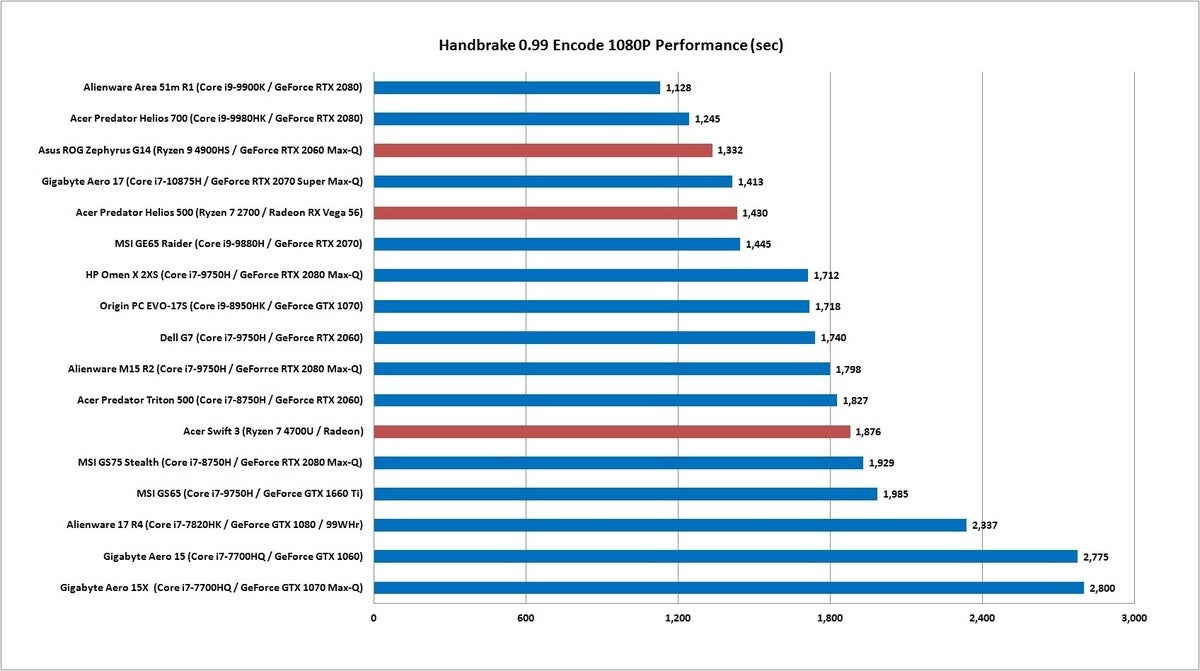 IDG
IDG Amazing: A Ryzen 7 4700U without SMT, can just about hang with 8th gen Core i7-8750H and Core i7-9750H chips.
The Ryzen 7 4700U delivers simply stunning public presentation that raises the bar for what we've make out to expect of U-class laptops. Only its battery life falls back to earth (and that may change As we determine many laptop implementations.) General, IT's yet more proof of just how practically of a game-changer the Ryzen 4000 CPUs are.
Source: https://www.pcworld.com/article/399104/ryzen-4000-performance-benchmarks-ryzen-7-4700u-beats-intel-h-class-mobile-chips.html
Posted by: morrisfromeannown.blogspot.com


0 Response to "Ryzen 4000 performance benchmarks: Ryzen 7 4700U beats Intel H-class mobile chips - morrisfromeannown"
Post a Comment